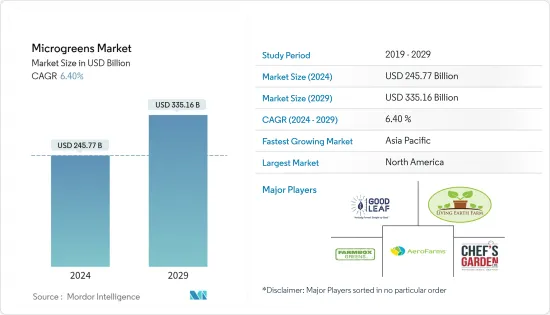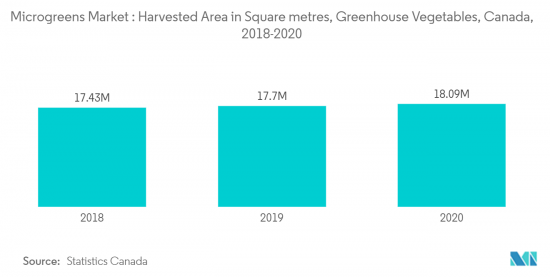 |
市場調査レポート
商品コード
1405681
マイクログリーン:市場シェア分析、産業動向・統計、成長予測、2024年~2029年Microgreens - Market Share Analysis, Industry Trends & Statistics, Growth Forecasts 2024 - 2029 |
||||||
● お客様のご希望に応じて、既存データの加工や未掲載情報(例:国別セグメント)の追加などの対応が可能です。 詳細はお問い合わせください。
| マイクログリーン:市場シェア分析、産業動向・統計、成長予測、2024年~2029年 |
|
出版日: 2024年01月04日
発行: Mordor Intelligence
ページ情報: 英文 120 Pages
納期: 2~3営業日
|
- 全表示
- 概要
- 目次
マイクログリーン市場規模は2024年に2,457億7,000万米ドルと推定され、2029年には3,351億6,000万米ドルに達すると予測され、予測期間(2024-2029年)のCAGRは6.40%で成長する見込みです。

主なハイライト
- マイクログリーンは、食用に利用できる柔らかくて小さな野菜グリーンです。強力な芳香を放ち、さまざまな色や食感を持つため、通常、パスタ、ピザ、オムレツ、サラダなどさまざまな料理の色、食感、風味を改善するために使用されます。マイクログリーンの消費に関連する健康上の利点は、体重管理、慢性疾患の回避、免疫力の向上、精神衛生の改善に役立つことです。
- マイクログリーンの市場を牽引しているのは、味を引き立て、皿に彩りよく盛り付けるシェフたちだが、このセグメントで新たな成長を後押ししているもうひとつのニッチ産業、化粧品もあります。これらのマイクログリーンは、シャンプーやスキンケア製品のような消費者アイテムのオイルや原料に加工されます。マイクログリーンは、他の多くの微量元素に加え、多くのビタミンAとBを含んでおり、パーソナルケア製品メーカーにとって非常に魅力的な原料となっています。長期的には、これがマイクログリーンの需要を押し上げると予想されます。
- ブロッコリー、レタス、ルッコラ、バジルは、水耕栽培や垂直農法によって様々な地域で栽培されている重要なマイクログリーンの一部です。北米は2021年に最大の市場シェアを占めました。米国がこの地域のシェアに大きく貢献しており、カナダ、メキシコがこれに続いています。
マイクログリーンの市場動向
屋内農業の採用増加
人口増加により食糧需要が増加し、生産可能な土地が減少したため、農家は室内農業のようなハイテク生産方法に目を向けるようになった。これに伴い、健康志向の高まりから、人々は栄養素の豊富な食事を摂取するようになり、室内農業の導入につながった。消費者は家庭で室内農業を実践しているだけでなく、大手の温室でも大々的に栽培しています。そのため、マイクログリーンの市場は今後数年で成長すると予想されています。インテリジェンス・プラットフォームであるArtemisの調査によると、室内栽培の生産者のほぼ16%がマイクログリーンの生産に携わっています。
これらの要因に加えて、農業機械化の受け入れの増加や、水耕栽培、エアロポニックス、アクアポニックスなどのハイテク農業技術に関する知識の増加が、マイクログリーン産業の拡大を促進すると予想されています。世界中の消費者が健康的な食生活を志向する中、需要は増加しており、マイクログリーンの生産量は今後数年で増加すると予想されています。このような保護栽培の採用増加により、市場は緩やかに成長しています。
さらにカナダでは、マイクログリーンを含む温室野菜の生産が着実に増加しており、数十年にわたる成長動向は近い将来も続くと予想されます。温室技術の成功がマイクログリーン市場を後押ししています。そのため、需要の伸びとともに収益も安定し、それが市場の成長を後押ししています。

北米はマイクログリーンの最大市場の1つ
北米は2021年にマイクログリーン産業で最大のシェアを占めました。健康上の利点やバランスの取れた食生活に対する意識の高まりにより、この地域の人々は緑黄色野菜サラダやマイクログリーンを含む有機ベースの食品を食生活に取り入れるようになり、これがマイクログリーン市場を拡大しています。屋内栽培や垂直農法を強化することで、米国の生産者はマイクログリーンを大規模に生産できるようになった。例えば、情報プラットフォームAgrilystによると、米国における温室の分布は地域によって異なるが、温室でのマイクログリーンの生産は南部と北東部で最も多く、2020年にはそれぞれ71%と59%を占めています。さらに、カリフォルニア州の農家では水耕栽培が最も高い収益を生み出しています。そのため、ブロッコリー、レタス、サラダ野菜など、この農法に最適な作物が栽培されています。
多くの小売業者は、米国の地元レストランや農家に、水耕栽培や垂直農法で栽培できる「Certified Naturally Grown」マイクログリーンの種子を提供しています。カナダの農家は、照明に電力を必要とするため、マイクログリーンの栽培には温室栽培よりも室内栽培に頼っています。屋内で栽培することで、屋外栽培の害虫や病気の問題の多くを解消できます。このように、有機農家は、風味の強化やカラフルな添え物として使用するシェフからの需要の増加により、この市場に参入しています。
マイクログリーン産業の概要
マイクログリーン市場は断片化されており、多くの大手企業が存在するため競争が激しいです。市場に貢献しているマイクログリーン市場の主要企業には、Farmbox Greens LLC、The Chef's Garden Inc.、Aerofarms LLC、Living Earth Farms、Good Leaf Farms、Jiangsu Skyplant Greenhouse Technology、Shanghai Dehuan Industryなどがあります。主要企業は、マイクログリーン市場の世界の成長のために新製品の発売や拡大戦略を採用しています。
その他の特典
- エクセル形式の市場予測(ME)シート
- 3ヶ月間のアナリストサポート
目次
第1章 イントロダクション
- 調査の前提
- 市場の定義と調査範囲
第2章 調査手法
第3章 エグゼクティブサマリー
第4章 市場力学
- 市場概要
- 市場促進要因
- 市場抑制要因
- バリューチェーン分析
第5章 市場セグメンテーション
- タイプ
- ブロッコリー
- レタス・チコリ
- ルッコラ
- バジル
- フェンネル
- ニンジン
- ひまわり
- ラディッシュ
- エンドウ豆
- その他
- 農業
- 屋内農業
- 垂直農業
- 商業温室
- その他
- 成長培地
- ピートモス
- 土壌
- ココナッツコアー
- 薄葉紙
- その他
- 流通チャネル
- ハイパーマーケット/スーパーマーケット
- レストラン
- その他
- 地域
- 北米
- 米国
- カナダ
- メキシコ
- その他北米地域
- 欧州
- オランダ
- スペイン
- ドイツ
- フランス
- その他欧州
- アジア太平洋
- 中国
- インド
- シンガポール
- オーストラリア
- その他アジア太平洋地域
- 南米
- ブラジル
- チリ
- アルゼンチン
- その他南米
- 中東・アフリカ
- アルジェリア
- サウジアラビア
- エジプト
- 南アフリカ
- その他中東・アフリカ
- 北米
第6章 競合情勢
- 最も採用されている戦略
- 市場シェア分析
- 企業プロファイル
- AeroFarms LLC
- Goodleaf Farms
- Living Earth Farm
- Farm Box Greens
- Jiangsu Skyplant Greenhouse Technology Co. Ltd
- Shanghai Dehuan Industry Co. Ltd
- Chef's Garden Inc.
- Madar Farms
- Metro Microgreens
- Gotham Greens
- Greenbelt Microgreens
第7章 市場機会と今後の動向

The Microgreens Market size is estimated at USD 245.77 billion in 2024, and is expected to reach USD 335.16 billion by 2029, growing at a CAGR of 6.40% during the forecast period (2024-2029).
Key Highlights
- Microgreens are soft, tiny vegetable greens that are available for consumption. They are usually used to improve the color, texture, or flavor of various cuisines such as pasta, pizza, omelets, and salads due to their powerful aromatic flavor and range of colors and textures. The health benefits associated with the consumption of microgreens are they help manage weight, avoid chronic medical conditions, boost immunity, and improve mental health.
- The microgreens market is driven by chefs that use them as flavor enhancements and as colorful garnishes on their plates, but there is another niche industry that pushes new growth within this segment, cosmetics. These micro greens are processed into oils and ingredients for consumer items like shampoo and skincare products. Microgreens contain a lot of vitamins A and B in addition to many other micro-elements, making them very attractive ingredients for personal care product manufacturers. Over the long term, this is expected to boost the demand for microgreens.
- Broccoli, lettuce, arugula, and basil are some of the important microgreens grown across various regions through hydroponics and vertical farming. North America accounted for the largest market share in 2021. The United States is a major contributor to the share of the region, followed by Canada and Mexico.
Microgreens Market Trends
Rise in Adoption of Indoor Farming
The growing population has led to increased food demand which made farmers turn towards high-tech production methods like indoor farming because of the decrease in productive land. Along with this, the growing health consciousness has led people to consume a diet full of nutrients, which has led to the adoption of indoor farming practices. Consumers not only practice indoor farming at home, but it is also largely being cultivated in major greenhouses. Thus, the market for microgreens is anticipated to grow in the years to come. According to a survey by Artemis, an intelligence platform, almost 16% of growers in indoor cultivation are involved in microgreens production.
In addition to these factors, the increased acceptance of agricultural mechanization and increased knowledge of high-tech farming techniques like hydroponics, aeroponics, and aquaponics are anticipated to promote the expansion of the microgreens industry. With consumers across the world turning toward healthy diets, the demand is increasing, and the production of microgreens is anticipated to increase in the coming years. This rising adoption of protected cultivation has led the market to grow moderately.
Furthermore, in Canada, there has been a steady increase in greenhouse vegetable production, including microgreens, and it is anticipated that the multi-decade trend of growth will continue in the near future. The success of greenhouse technology is boosting the microgreens market. Thus, the revenue has stabilized with the growth in demand, which, in turn, has aided in the market growth.

North America is One of the Largest Markets for Microgreens
North America accounted for the largest share of the microgreens industry in 2021. The rise in the awareness of health benefits and balanced diets has made people in this region include green vegetable salads and organic-based food items including microgreens in their diets which is increasing the market for microgreens. With the help of enhanced indoor and vertical farming practices, US growers have been able to produce microgreens on a large scale. For instance, According to Agrilyst, an intelligence platform, the distribution of greenhouses in the United States in various areas varied, but the production of microgreens in greenhouses was most prevalent in the South and Northeast regions, accounting for 71% and 59%, respectively in 2020. Moreover, hydroponic farming generates the highest revenue for Californian farmers. Therefore, crops such as broccoli, lettuce, and salad vegetables are grown, which are best suited for this farming technique.
Many retailers are providing "Certified Naturally Grown" microgreen seeds to local restaurants and farmers in the United States, which can be grown hydroponically and through vertical farming in the country. Canadian farmers rely on indoor farming than greenhouse farming for growing microgreens because of the electricity needed for lighting. Growing indoors eliminates many of the pest and disease problems of outdoor production. Thus, organic farmers are tapping into this market due to the increased demand from chefs that use them as flavor enhancements and colorful garnishes.
Microgreens Industry Overview
The microgreens market is fragmented and highly competitive due to the presence of many major players. The key players in the microgreens market contributing to the market include Farmbox Greens LLC, The Chef's Garden Inc., Aerofarms LLC, Living Earth Farms, Good Leaf Farms, Jiangsu Skyplant Greenhouse Technology Co. Ltd, and Shanghai Dehuan Industry Co. Ltd. The major players are adopting new product launches and expansion strategies for global growth in the microgreens market.
Additional Benefits:
- The market estimate (ME) sheet in Excel format
- 3 months of analyst support
TABLE OF CONTENTS
1 INTRODUCTION
- 1.1 Study Assumptions
- 1.2 Market Definition and Scope of the Study
2 RESEARCH METHODOLOGY
3 EXECUTIVE SUMMARY
4 MARKET DYNAMICS
- 4.1 Market Overview
- 4.2 Market Drivers
- 4.3 Market Restraints
- 4.4 Value Chain Analysis
5 MARKET SEGMENTATION
- 5.1 Type
- 5.1.1 Broccoli
- 5.1.2 Lettuce and Chicory
- 5.1.3 Arugula
- 5.1.4 Basil
- 5.1.5 Fennel
- 5.1.6 Carrots
- 5.1.7 Sunflower
- 5.1.8 Radish
- 5.1.9 Peas
- 5.1.10 Other Types
- 5.2 Farming
- 5.2.1 Indoor Farming
- 5.2.2 Vertical Farming
- 5.2.3 Commercial Greenhouses
- 5.2.4 Other Farming
- 5.3 Growth Medium
- 5.3.1 Peat Moss
- 5.3.2 Soil
- 5.3.3 Coconut Coir
- 5.3.4 Tissue Paper
- 5.3.5 Other Growth Mediums
- 5.4 Distribution Channel
- 5.4.1 Hypermarkets/Supermarkets
- 5.4.2 Restaurants
- 5.4.3 Other Distribution Channels
- 5.5 Geography
- 5.5.1 North America
- 5.5.1.1 United States
- 5.5.1.2 Canada
- 5.5.1.3 Mexico
- 5.5.1.4 Rest of North America
- 5.5.2 Europe
- 5.5.2.1 Netherlands
- 5.5.2.2 Spain
- 5.5.2.3 Germany
- 5.5.2.4 France
- 5.5.2.5 Rest of Europe
- 5.5.3 Asia-Pacific
- 5.5.3.1 China
- 5.5.3.2 India
- 5.5.3.3 Singapore
- 5.5.3.4 Australia
- 5.5.3.5 Rest of Asia-Pacific
- 5.5.4 South America
- 5.5.4.1 Brazil
- 5.5.4.2 Chile
- 5.5.4.3 Argentina
- 5.5.4.4 Rest of South America
- 5.5.5 Middle East & Africa
- 5.5.5.1 Algeria
- 5.5.5.2 Saudi Arabia
- 5.5.5.3 Egypt
- 5.5.5.4 South Africa
- 5.5.5.5 Rest of Middle East & Africa
- 5.5.1 North America
6 COMPETITIVE LANDSCAPE
- 6.1 Most Adopted Strategies
- 6.2 Market Share Analysis
- 6.3 Company Profiles
- 6.3.1 AeroFarms LLC
- 6.3.2 Goodleaf Farms
- 6.3.3 Living Earth Farm
- 6.3.4 Farm Box Greens
- 6.3.5 Jiangsu Skyplant Greenhouse Technology Co. Ltd
- 6.3.6 Shanghai Dehuan Industry Co. Ltd
- 6.3.7 Chef's Garden Inc.
- 6.3.8 Madar Farms
- 6.3.9 Metro Microgreens
- 6.3.10 Gotham Greens
- 6.3.11 Greenbelt Microgreens
